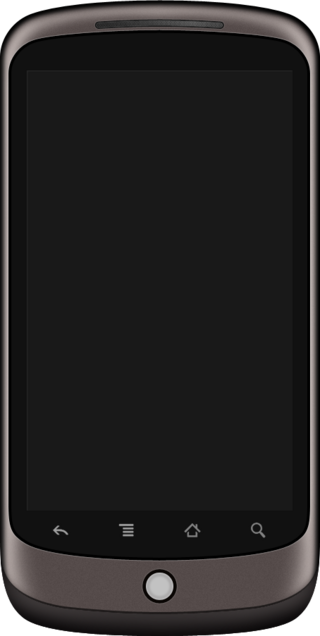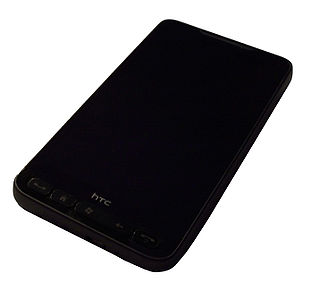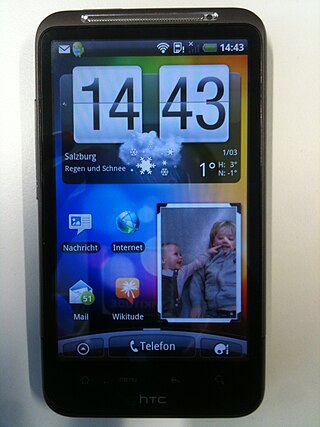
The HTC TyTN II is an Internet-enabled Windows Mobile Pocket PC smartphone designed and marketed by HTC Corporation of Taiwan. It has a tilting touchscreen with a right-side slide-out QWERTY keyboard. The TyTN II's functions include those of a camera phone and a portable media player in addition to text messaging and multimedia messaging. It also offers Internet services including e-mail, instant messaging, web browsing, and local Wi-Fi connectivity. It is a quad-band GSM phone with GPRS, EDGE, UMTS, HSDPA, and HSUPA.

The Nexus One is an Android smartphone designed and manufactured by HTC as Google's first Nexus smartphone. The Nexus became available on January 5, 2010, and features the ability to transcribe voice to text, an additional microphone for dynamic noise suppression, and voice guided turn-by-turn navigation to drivers.

HTC Magic is an Android smartphone designed and manufactured by HTC. It is HTC's second Android phone after HTC Dream, HTC's first touch-only flagship Android device and the second Android phone commercially released, as well as the first Android phone without a keyboard.

HTC Hero is the third phone manufactured by HTC running the Android platform, announced on June 24, 2009 in London.

HTC Sense is a software suite developed by HTC, used primarily on the company's Android-based devices. Serving as a successor to HTC's TouchFLO 3D software for Windows Mobile, Sense modifies many aspects of the Android user experience, incorporating additional features, additional widgets, re-designed applications, and additional HTC-developed applications. The first device with Sense, the HTC Hero, was released in 2009. The HD2 running Windows Mobile 6.5, released later the same year, included Sense. Following the release of the Hero, all future Android devices by HTC were shipped with Sense, except for the Nexus One, the Desire Z, the HTC First, the Google Pixel and Pixel 2, and the Nexus 9 which used a stock version of Android. Also some HTC smartphones that are using MediaTek processors come without HTC Sense.

The HTC HD2, is a smartphone in the HTC Touch family designed and manufactured by HTC. The HD2 natively runs the Windows Mobile 6.5 operating system, and was released in Europe in November 2009, in Hong Kong in December 2009, and in other regions including North America in March 2010. The phone is the successor to the HTC Touch HD, and is succeeded by the HTC HD7.

The Samsung Moment, known as SPH-M900, is a smartphone manufactured by Samsung that uses the open source Android operating system.

The HTC Desire is the first smartphone of the Desire series developed by HTC. It was announced on 16 February 2010 and released in Europe and Australia in the second quarter of the same year. The HTC Desire was HTC's third flagship phone running Android 2.1 Eclair which can be upgraded to 2.2 Froyo or 2.3 Gingerbread. Internally it bears a strong resemblance to the Nexus One, but differs in some features.

The HTC Evo 4G is a smartphone developed by HTC Corporation and marketed as Sprint's flagship Android smartphone, running on its WiMAX network. The smartphone was launched on June 4, 2010. It was the first 4G enabled smartphone released in the United States.

The HTC Droid Incredible (ADR6300) is a smartphone manufactured by HTC Corporation using the Android operating system. It was released on April 29, 2010, and is available through Verizon Wireless only. The device is similar to the Sprint HTC Evo 4G. The device has been succeeded by the HTC Incredible S and the HTC ThunderBolt. The device was discontinued in March 30, 2011.

The HTC Wildfire is a smartphone developed by the HTC Corporation, that was announced on 17 May 2010 and released in Europe in June of the same year. It is powered by a 528 MHz Qualcomm processor and runs the Android operating system, version 2.2. It includes a TFT LCD capacitive touchscreen and a 5-megapixel camera. It has been described as a "Mini HTC Desire", and is perceived to be a follow-up model to the previous year's Tattoo.

The T-Mobile myTouch 3G Slide is a smartphone designed and manufactured by HTC, and sold by T-Mobile USA. HTC's name for the device during development was Espresso. The 3G Slide was unveiled by T-Mobile USA on May 4, 2010, pre-orders began May 23, 2010 and the device went on sale June 2, 2010.

The HTC Aria is a smartphone manufactured by HTC Corporation that runs the Android operating system with HTC Sense.

The HTC Desire HD is an Android smartphone by HTC Corporation. It was unveiled at a press event in London hosted by HTC on September 15, 2010, and was made available for sale in October in Europe and in January 2011 in Canada. The Desire was HTC's fourth flagship Android device until the release of their new line of flagship model, the HTC Sensation.

The HTC Evo 3D is a 3D-enabled Android smartphone developed by HTC, released exclusively in the United States through Sprint, and was re-released as a pre-paid smartphone by Virgin Mobile in May 2012 as the HTC Evo V 4G. A variation of Sprint's flagship HTC Evo 4G, the device is distinguished by its pair of 5 MP rear cameras, which made the Evo 3D the first cell phone to do so, which can be used to take photos or video in stereographic 3D, which can be viewed on its autostereoscopic display without the need for 3D glasses. Several GSM variants are also available in Canada, Europe and Asia.

The HTC Sensation is a smartphone designed and manufactured by HTC Corporation that runs the Android 2.3 Gingerbread software stock. Officially announced by HTC on April 12, 2011, the HTC Sensation was launched by Vodafone in key European markets including the United Kingdom on May 19, 2011 and by T-Mobile in the United States on June 12, 2011. It was HTC's fifth flagship Android phone and the first HTC phone to support the HTC Sense 3.0 user interface. At the time of its release, the Sensation XE was the world's fastest Android phone.

The HTC Wildfire S is a smartphone developed by the HTC Corporation. The model was announced on 15 February 2011 at the Mobile World Congress and released in Europe three months later.

The HTC One S is a premium smartphone designed and manufactured by HTC as part of the HTC One series which has Beats Audio and runs the Android 4.0 "Ice Cream Sandwich" mobile operating system with HTC Sense. Announced by HTC on 26 February 2012, the HTC One S was scheduled for official release on 2 April 2012. The first phones were sold on March 30. In the United States, the One S is carried by T-Mobile and Solavei.

The HTC One V is a smartphone designed and manufactured by HTC as part of the HTC One series which runs Android 4.0.3 with an HTC Sense 4.0 overlay. This phone is constructed from an aluminum unibody. Its design resembles the HTC Legend released in 2010. It features a 5-megapixel camera, 3.7-inch touchscreen, 512 MB RAM, a 1 GHz processor, and Beats audio. Officially announced by HTC on 26 February 2012, the HTC One V was released on 26 April 2012 in the UK.

The Windows Phone 8X by HTC is a smartphone that was announced by HTC Corporation on September 19, 2012.




















